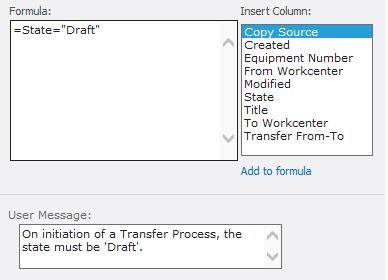I’m provisioning a ‘BPM-light’ process in our SharePoint ‘business platform’. Utilized SharePoint building blocks are Document Sets, Content Types and SharePoint Designer Workflow. The ‘light’ solution worked correct when demonstrating on first evaluation-time ('sprint') to the designated end-users. Of course they had some additional fine-tuning requests, which is just the way to deliver and align on business functionality in agile manner. After I implemented some of the minor additional changes, the workflow no longer functioned and reported an error.
The workflow error message exposed a problem with setting a value in the current item, of type Choice field:
This worked before, what changed that made it fail now?

Well, the explanation was found in my recent changes: To ensure correct user input when creating a new Document Set, I added a Validation rule. The validation rule is simple, on creation the State value must always be ‘Draft’ (*)

The explanation of the introduced error when trying to set ‘State’ field-value from workflow execution, is that the validations are not limited to UI/form handling. The validation settings are applied on SharePoint level whenever a change to item is made. And thus also applied for the item change initiated from workflow.
I tried to build in a differentiator in the validation to only require ‘State=Draft’ upon Document Set creation. But I could not get a working validation rule for that. I tried:
- =OR([Created]<[Modified],[State]="Draft")
- =OR((INT(Modified-Created) > 0),(State="Draft"))
- =OR((DATEDIFF(Modified,Created,"s")>0),(State="Draft"))
(*) Note: For optimal User Experience I would have preferred to modify the form itself, and hide or disable the ‘State’ field to avoid the user changing it to non-allowed value. However SharePoint does not support to customize the NewForm in case of Document Sets. The only option you have is to replace the standard DocumentSet page (_layouts/NewDocSet.aspx) for another server-side based version [How to: Create a New Document Set Form in SharePoint Server 2010 (ECM)], but our SharePoint governance rules (‘future proof solutions’) do not allow to do that.


No comments:
Post a Comment